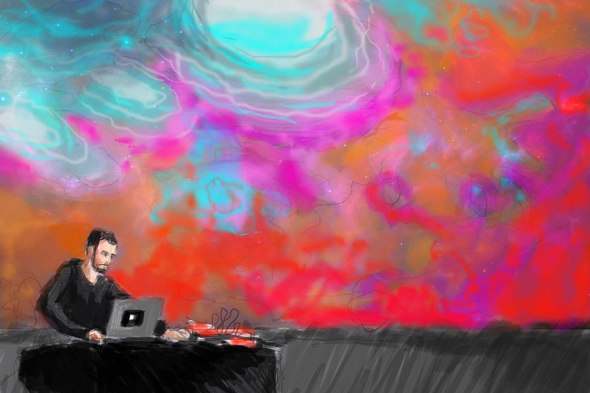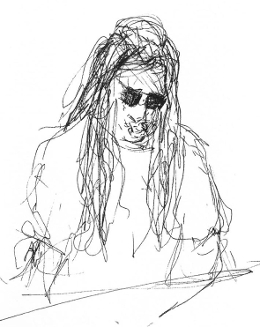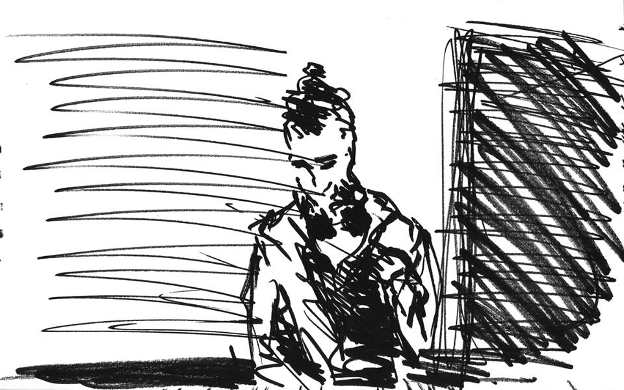Unsound 2013: In review

Scott Wilson outlines some of the many highlights of last week’s Unsound festival in Krakow.
When the organisers of the Krakow-based Unsound festival announced earlier this year that part of the festival’s “Interference” theme was going to be to ban all photography, the shocked reaction from some quarters seemed surprising. Surely this should just be a given? The pervading nature of photography, thorough cameras and phones alike, has been ruining live musical experiences for years, and the overriding memory of this festival for many will be the sense of freedom offered by that. Although the odd picture was taken when the alcohol consumption had rendered certain inhibitions somewhat compromised, for the most part cameras were absent, and full attention could be placed on the music (hence the variety of sketches by attendees which adorn this page).
The sheer amount of that music was somewhat overwhelming in its diversity and density, and as is always the way with festivals, concessions had to be made to sleeping, eating, and, occasionally, drinking; as such, some artists were missed, and some were given a wide berth as they failed to catch the imagination in quite the way I’d hoped. Demdike Stare and Andy Stott’s set felt lacking in the more exciting elements of their respective material, while the clash between Laurel Halo and Stellar OM Source meant I only caught a fraction of the former’s excellent set.
What seemed most striking about the Unsound experience however, is that even if artists were missed, the festival’s theme, discussions, and one-off collaborations ensure that pathways between the different types of music emerge in the way they simply don’t at other festivals; this isn’t a place where the dance music exists alongside a token metal band, but where everything engages in constant dialogue with one another. On the surface of things there should be nothing to link the raw, hardware techno of Svengalisghost and the playful, elegiac performance of Charlemagne Palestine and Rhys Chatham, but their unpredictable improvised performances which tied into the theme of “Interference” were just one way in which disparate acts felt bonded together.
As such, rather than attempt to sum up my experiences as a whole, I’ve selected the five things that stuck with me the most, be it through solo performance, or the way the themes of the festival seemed to lodge in my brain long after the vodka hangover had worn off.
Roly Porter & Keith Fullerton Whitman
Although most go to Unsound for the sheer abandon of the Hotel Forum events, an empty communist era hotel where the majority of the electronic events take place, it’s the evening events that take place at different venues across the city that are the jewels in the festival’s crown: Earth’s doom metal in a disused tram shed, Julianna Barwick in the gothic surrounds of St Catherine’s Church, Roly Porter & Keith Fullerton Whitman in the Kijów Centrum cinema amongst them, and each of these performances felt bespoke and tailored to the surroundings, even if that wasn’t the intention. The one that stuck with me however, was the collaboration between Roly Porter & Keith Fullerton Whitman on Friday; with the concession stands in the ornately decorated cinema foyer selling popcorn and hot dogs as usual, waiting in the foyer felt more like waiting for a movie than a performance, and in a sense that’s what the audience got.

Going under the name Dream Cargoes, the collaboration was inspired by a J.G Ballard story of the same name, in which a sailor discovers a new ecosystem has developed within a wrecked freighter carrying a cargo of deadly chemicals. Together with video artists Marcel Weber and Lucy Benson, and the assistance of the Sinfonia Krakowia, the duo managed to construct a gripping musical narrative. The visual element, which can so often be lacking felt very much the focus; a desolate, almost Martian, landscape hummed vividly with subtly shifting textures and colours, and across the hour-long performance, the audience were taken gradually closer into the developing ecosystem, with microsopic level of detail unfolding like a new universe, where what looked like iron filings danced around bacterial shapes the colour of sulphurous rocks and mud pools. If there was one complaint it’s that the pair didn’t always seem to be working together; the sweeping, cinematic opening movement seemed very much the domain of Roly Porter, while the more frenzied second half were dominated by the fractured modular tones emanating from Keith Fullerton Whitman’s hardware. But this was an immersive cinematic experience in cinematic surrounds, and an unsettling one at that.
Svengalisghost/Stellar OM Source
If this year’s Unsound’s main theme was “Interference”, then its unofficial theme was surely that of live hardware electronic performance designed for dancing. Previous editions of Unsound have had more than their fair share of live electronic acts, but it seemed particularly pronounced at this year’s festival; on Friday night live electronic acts outnumbered DJs, with only Helena Hauff, DJ Qu and DJ Richard the only bonafide DJs on the night (DJ Richard’s White Material cohorts Young Male and Galcher Lustwerk both played live, or semi-live). This idea of live performance – specifically in an improvisational sense was discussed at a panel moderated by The Quietus’ Rory Gibb earlier in the day, in which he discussed the recent boom in live improvised hardware performance with L.I.E.S. artist Svengalisghost, Juju & Jordash’s Jordan Czamanski and RVNG’s recent Australian signings Gardland. The idea of “straight to tape hardware jams” has become so commonplace in recent times that it’s almost become a marketing device, but the contributions from the panel – particularly Svengalisghost – made a great defense of its continued potential in a club environment. Svengalisghost’s answer for why he adopts such a raw approach to sound – that he feels the need to reflect what he believes is a fairly dystopic society – may be difficult for some to swallow, but his sheer enthusiasm for his methods was not.
For Svengalisghost, the mistakes – faulty hardware, patches that don’t load – are the enablers for exciting live performance. I hadn’t intended to see Svengalisghost on the Friday night at the Hotel Forum, but whilst watching Underground Resistance, I seemed to be presented with exactly the kind of thing the panel were railing against; a group of men whose laptop setup felt a little too static to be fully engaging. They may have had the enthusiasm, and the ability to work a crowd verbally, but somehow it just didn’t seem to translate musically. Moving to room 2 for Svengalisghost’s set the difference was pronounced; the music grubbier, the tones harsher it felt more appropriate for the surroundings of the Hotel Forum’s crumbling surrounds than UR’s slick techno. I was fully castigated by some for my choice, but in the face of things it felt like there was just that bit more soul on display in Svengalisghost’s set.
It was a similar story with Stellar OM Source, who provided one of the standout live performances of the entire weekend earlier in the evening. Although she started comparatively early at 23.30, Christelle Gualdi wasted no time in turning the room into a sweating, heaving mess of bodies; throwing in the euphoric “Polarity” at the beginning of her set and moving on to “Par Amour”, Gualdi kept the energy going for an hour with some of the most colourful 303 lines I’ve heard. The difference between Svengalisghost and Stellar OM Source was pronounced – it was clear Gualdi wasn’t improvising all of her set at least, and the glittering colour of Gualdi’s set stood apart from Svengalisghost’s set – but the enthusiasm for performance shared by both made them two of the most infectious acts of the festival.

Dean Blunt/ Inga Copeland
It seemed somewhat odd to have Dean Blunt and Inga Copeland on the same bill, but not appearing on stage together since they went their separate ways this year. However, their solo performances provided some of the most confrontational performances of the festival, clearly chosen under the “Interference” banner for their shared ability to disrupt the normalised experience of musical performance. Blunt presented The Redeemer show on Friday in the Narodowy Stary Teatr, a performance which was certainly the more theatrical of the two; after making the audience wait for a considerable amount of time, the auditorium was plunged into darkness and subjected to the sound of ear-searing recorded rainfall for 10 minutes, which was so loud it sat more in the territory of noise. When Blunt did finally arrive, he was barely lit, Tracks like “The Pedigree”, “Demon”, “Flaxen” and “Walls Of Jericho” were all performed by Blunt as seriously as the failed relationship subject matter demanded, but as with his performances with Copeland in Hype Williams, the whole thing seemed loaded with moments designed to disrupt emotional engagement; the minder who stood behind Blunt for the entire performance lent an air of complete absurdity to proceedings, while the intense strobe lights accompanied by ear-splitting synth tones sought to completely alienate the audience through sheer discomfort.
It was only through Blunt’s collaborator Joanne Robertson, that a semblance of real emotion was allowed through the cracks, but her closing guitar solo which veered dangerously close to 80s rock pastiche seemed like a conscious effort to derail that. The response to Blunt’s set was mixed; it was much the same show as he performed at the 100 Club in London last month, and in that sense it’s difficult to see this as anything other than a travelling stage show. Maybe Blunt’s antics will start to wear as increasingly thin as the arguments that defend his carefully constructed persona, but a strange sense of unease lingered with me long enough to make it one of the festival’s more thought provoking, and strangely moving, performances.
But it was still fascinating to see how Copeland’s solo approach differed. Playing in Room 2 of the Hotel Forum on the Saturday night, she played a hardware set of what could only be described as fairly demented techno. Ramshackle rhythms dominated her set, often reaching speeds of 150bpm; at one point, just as her groove picked up pace, the track seemed to just fade into something else entirely. As hardware sets go it wasn’t exactly slick – the joins were definitely visible. It would be churlish to compare Inga Copeland’s performance to Blunt’s; they are separate entitles now, and both clearly have different musical aims now that they have parted, but there was something about her live vocals and basic melodies that just felt more honest than Blunt’s obvious showmanship. Given the sheer weight of critical discussion of the intentions behind Hype Williams as a duo, these two solo performances offered more insight into just what each was individually bringing to the project, but also showed that the potential for both to forge equally interesting solo careers.
RP Boo
If Svengalisghost and Stellar OM Source were the most enthusiastic live performers of the festival, then RP Boo was its happiest DJ. The footwork pioneer recorded an interview for the RA Exchange podcast the day before his set in which he revealed that not only was Unsound his first time playing outside of the USA, it was his first time travelling outside of the USA. Given his newfound popularity in Europe thanks to his recent Legacy album on Planet Mu, it seems wholly possible that the crowd he played to at Unsound was one of the biggest (if not the biggest) of his life.
 If that was the case, he certainly didn’t show any fear; there wasn’t a moment of his hour-long set in the Hotel Forum’s imposing Room 1 on Saturday night in which the man wasn’t in complete command of the crowd, and didn’t have a huge smile on his face. His DJing was flawless too; the fatigue felt by everyone by Saturday night must make its peak time slot one of the hardest to fill (especially sandwiched between Demdike Stare & Andy Stott and Pearson Sound), but dropping tracks like “Speakers R-4 (Sounds)” got the kind of reaction that jolted everyone back into life. His pacing was impeccable too; those who have heard his Legacy album will know it’s not a relentlessly forward moving experience like DJ Rashad’s recent Double Cup; it’s weird, it forces you off balance, and his set was peppered with similar moments that tied your whole body in knots.
If that was the case, he certainly didn’t show any fear; there wasn’t a moment of his hour-long set in the Hotel Forum’s imposing Room 1 on Saturday night in which the man wasn’t in complete command of the crowd, and didn’t have a huge smile on his face. His DJing was flawless too; the fatigue felt by everyone by Saturday night must make its peak time slot one of the hardest to fill (especially sandwiched between Demdike Stare & Andy Stott and Pearson Sound), but dropping tracks like “Speakers R-4 (Sounds)” got the kind of reaction that jolted everyone back into life. His pacing was impeccable too; those who have heard his Legacy album will know it’s not a relentlessly forward moving experience like DJ Rashad’s recent Double Cup; it’s weird, it forces you off balance, and his set was peppered with similar moments that tied your whole body in knots.
If there was one overriding thing that stuck with me, it was how completely unpretentious the whole thing was; towards the end he walked round to the front of the decks and engaged in his own bit of footwork dancing, putting himself the meagre efforts of the crowd to shame. However, this obviously wasn’t a set about showmanship, it was about inclusivity; it’s shameful to say, but I had never seen a footwork DJ until RP Boo’s set, yet I’ve never felt so at ease dancing to what was, essentially, a totally new experience for me. If you saw his set and weren’t a footwork convert afterwards, you may as well give up on the genre now.
White Material
For a label only four releases deep, with only three real artists to speak of, to hold down a whole room for an entire night is, to say the least, a brave programming decision. Even L.I.E.S, who have been in existence for over two years have only just started putting on label showcases, so for the comparatively inexperienced White Material trio of DJ Richard, Young Male, and Galcher Lustwerk to be given that responsibility could have gone either way. As it was they more than justified their presence at the festival, offering probably one of the most consistently exciting rooms at the festival, running proceedings in Room 3 of the Hotel Forum on Friday night. Each member undoubtedly brought their own vibe to proceedings, with a starting set from DJ Richard wasting little time in building to all out thumping beats despite his 10pm start; taking up the mantle at midnight, his fellow White Material founder Young Male performed a hybrid live and DJ set of hefty, strobing techno. Like the L.I.E.S. crew, the vibe the pair put across was very much no-nonsense, but with a sense that they take things perhaps a little less seriously.

However, it was undoubtedly Galcher Lustwerk’s performance that most people were excited about. His mix of original material for Blowing Up The Workshop and a sole 12” for White Material this year have elevated him to the status of near-deity to many (myself included), and to see him behind the decks almost took some of the magic away. However, the set itself, which saw him lay down live vocals over his own tracks, was exactly the kind of communal experience many were hoping for – much like the room itself, which became a reliable place to come back to throughout the night between the bigger acts. It became even clearer over the course of the night that Lustwerk is a necessary counterpart to Young Male and DJ Richard, offering the deeper moods that the other two lack. With a few more records under their belt, and a bit more experience working crowds, there’s no reason why White Material won’t be doing big things next year.

Scott Wilson
Image credits:
Kwadrofonik at Tempel Synagogue by Michael White.
Roly Porter during Dream Cargoes concert at Kino Kijów by Edyta Żmudzka
Laurel Halo at Hotel Forum by Magda Migas
RP Boo at Hotel Forum by Antek
Young Male at Hotel Forum by Antek
DJ Richard at Hotel Forum. By Antek